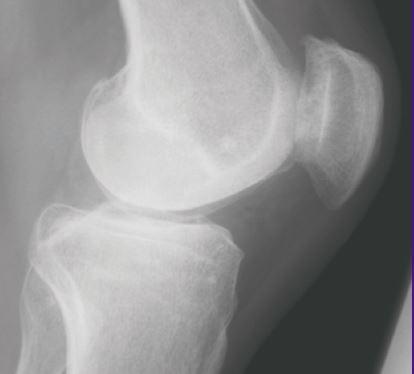New therapeutic targets for osteoarthritis pain

This is a lateral view of a left osteoarthritic knee. Credit: David A. Walsh and Joanne Stocks
It covers the limitations of existing treatments and introduces the latest understanding of the complex mechanisms behind OA pain, which offers exciting new possibilities and potential new treatment targets.
Recent patents registered suggest that areas of future OA therapies could target inflammation, bone and cartilage; sensory nerves; tissue engineering and dietary supplements.
Two new areas of intensive research, which are discussed, are the use of combination therapies and the development of biomarkers to target effective pain treatment. Due to the multiple mechanisms of the disease, pharmacological therapies alone may not work and instead require combining with psychological and physiotherapeutic approaches.
The potential of imaging, genetic or wet biomarkers to predict pain and to stratify patients most likely to benefit from specific treatment is explored. Combining biomarkers that cross different disciplinary boundaries might increase their value in predicting treatment need or outcome.
Through increased understanding of the mechanisms that underlie OA pain, new drugs could also come from re-purposing those developed for other conditions as well as novel compounds which target pain mechanisms specific to the joint.
OA is the most common form of arthritis, yet unfortunately, the most effective treatment currently available for improving quality of life is total joint replacement.
###
About our Society and Journals
SLAS (Society for Laboratory Automation and Screening) is an international community of more than 27,000 individual scientists, engineers, researchers, technologists and others from academic, government and commercial laboratories. The SLAS mission is to be the preeminent global organization providing forums for education and information exchange and to encourage the study of, and improve the practice of life sciences discovery and technology.
SLAS DISCOVERY 2016 Impact Factor 2.444. Editor-in-Chief Robert M. Campbell, Ph.D., Eli Lilly and Company, Indianapolis, IN (USA). SLAS Discovery (Advancing Life Sciences R&D) was previously published (1996-2016) as the Journal of Biomolecular Screening (JBS).
SLAS TECHNOLOGY: 2016 Impact Factor 2.850. Editor-in-Chief Edward Kai-Hua Chow, Ph.D., National University of Singapore (Singapore). SLAS Technology (Translating Life Sciences Innovation) was previously published (1996-2016) as the Journal of Laboratory Automation (JALA).
Follow SLAS on Twitter at @SLAS_Org.
Follow SLAS on Facebook at SocietyforLaboratoryAutomationandScreening
Follow SLAS on YouTube at SLASvideo.
Follow SLAS Americas on LinkedIn at Society for Laboratory Automation and Screening (SLAS Americas)
Follow SLAS Europe on LinkedIn at Society for Laboratory Automation and Screening Europe (SLAS Europe)
Media Contact
All latest news from the category: Health and Medicine
This subject area encompasses research and studies in the field of human medicine.
Among the wide-ranging list of topics covered here are anesthesiology, anatomy, surgery, human genetics, hygiene and environmental medicine, internal medicine, neurology, pharmacology, physiology, urology and dental medicine.
Newest articles

Bringing bio-inspired robots to life
Nebraska researcher Eric Markvicka gets NSF CAREER Award to pursue manufacture of novel materials for soft robotics and stretchable electronics. Engineers are increasingly eager to develop robots that mimic the…

Bella moths use poison to attract mates
Scientists are closer to finding out how. Pyrrolizidine alkaloids are as bitter and toxic as they are hard to pronounce. They’re produced by several different types of plants and are…

AI tool creates ‘synthetic’ images of cells
…for enhanced microscopy analysis. Observing individual cells through microscopes can reveal a range of important cell biological phenomena that frequently play a role in human diseases, but the process of…





















